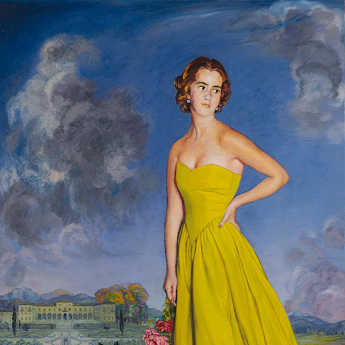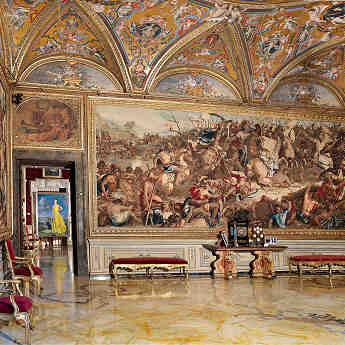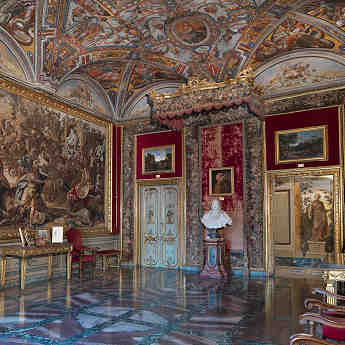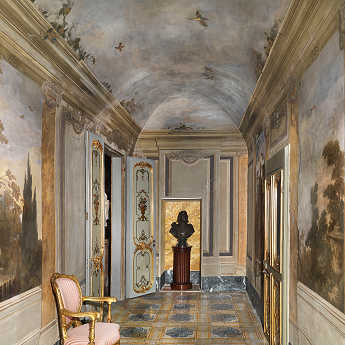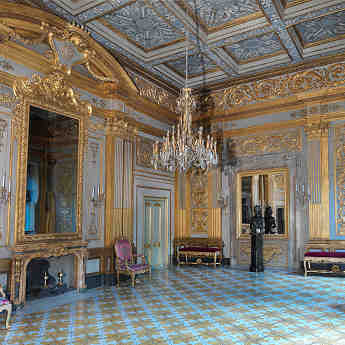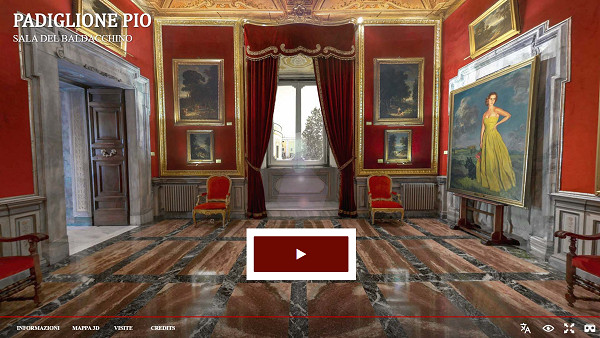A warm welcome by Princess Sveva
The Pio Pavilion is dedicated to Princess Donna Sveva Colonna (1910-1999), who married in 1932 the Spanish Prince Don Alfonso Pio Falcò (1903-1967). Donna Sveva was the first of the two children of Princess Donna Isabelle Colonna Sursock, and therefore sister of Prince Don Aspreno Colonna, father of the current Princes. Donna Sveva had no children; she’s portrayed, at the age of 25, in the great painting by the famous Spanish artist Ignacio Zuloaga (1870-1945) together with her dog Whisky in front of her husband’s villa in Imbersago (Lecco), Villa Mombello, and is also represented in a bronze bust by Antonio Berti (1904-1990). The six large seventeenth-century tapestries (French manufacture of Gobelins, XVIIth century) represent some moments of the life of Alexander the Great (4th century BC) and come from the collection of Philip III Colonna (XVIIIth century).The bust of Pope Benedict XIV (1740-1758) – Prospero Lambertini (1675-1758), – comes from the Pio collection as well as the portrait and busts of Donna Sveva and of the spanish King Philip IV (1605-1665).
- Portrait of Princess Sveva
- The Cornucopia Hall
- The Room of the Baldachin
- The Galleriola
- The Majolica Room
The rooms that now make up the Pio Pavilion were part of the cardinal’s apartment, once inhabited by three Colonna cardinals: Ascanio (16th century), Girolamo I (17th century) and Girolamo II (18th century).
THE CORNUCOPIA HALL
The Cornucopia Hall and the following Room of the Baldachin have ceilings decorated in the late 16th century (1588-1592) as part of the vast decorative campaign promoted by Cardinal Ascanio Colonna (1560-1608).
Both rooms were subsequently restored in the mid-seventeenth century by Cardinal Girolamo I Colonna (1604-1666). The door frames bearing the inscriptions HIERONYMUS CARDINALIS COLUMNA DUX ET PRINCEPS, the floral decorations painted in the lunettes that run at the base of the vaults and the restoration of the sixteenth-century paintings date back to this period.
The ceiling has an extremely rich decoration on a gold background in bright colors that develops around the large Colonna coat of arms depicted in the center surrounded by the collar of the Order of the Golden Fleece, the Turkish banners and flags with the insignia of Pope Pius V (pontificate 1566-1572) and the Spanish Kingdom of Castile and León, references to the victorious battle of Lepanto (1571).
The frescoes recall the cultural and ecclesiastical role of Cardinal Ascanio Colonna through allegorical figures of Virtue and the emblems of episcopal, cardinal and papal power supported by winged figures and putti. Stories from the Old Testament are represented in the four ovals surrounding the coat of arms: The Creation of Adam, the Creation of Eve, the Original Sin, the Expulsion of the Progenitors from Paradise.
The decoration of the walls with tapestries and painted fabric panels dates back to a renovation campaign entrusted by Cardinal Girolamo II (1708-1763) to architect Paolo Posi in the mid- eighteenth century (1756-1763).
The four French tapestries manufactured by the Gobelins, were woven in Paris in the 17th century on the basis of a famous cycle of paintings made for the French king Louis XIV by Charles Le Brun (1619-1690), superintendent of the French royal manufactures. Purchased by Lorenzo Onofrio Colonna (1637-1689) for 982 shields, they represent the Stories of Alexander the Great and recall significant episodes of the campaigns of the Macedonian ruler in Asia (clockwise from the wall in front of the windows):
- The battle of Grànico: (334 C.), first clash between Alexander and the Persian army in Asia Minor (today’s Turkey).
- The family of Darius pays homage to Alexander the Great after the battle of Isso (333 C.).
- The battle at the Idaspe river (326 C.), the last great battle of Alexander fought against the Indian king Poro in the Punjab region (today’s Pakistan).
- The defeat of the Indian king Poro (326 C.).
To complete the decoration of the walls, the brothers Stefano and Giuseppe Pozzi (18th century) created for the spaces without tapestries seven panels depicting putti and war trophies painted with vegetable pigments called grass juices, which allowed to obtain an effect similar to that of real tapestries thus creating a unitary whole.
The floor in yellow Siena marble inlaid with a cornucopia in the center and four bows in red of France in the corners, was laid in 1948 by the will of Donna Isabelle (1889-1984) and executed by the Medici Firm on a project by architect Clemente Busiri Vici.
THE ROOM OF THE BALDACHIN
The decoration of the vault dates back to the decorative campaign promoted by Cardinal Ascanio Colonna (1560-1608) in the late sixteenth century, with restorations from the mid-seventeenth century. At the center of the ceiling is the coat of arms of the Colonna family surmounted by the crown and the bifid siren flanked by two putti supporting the flags adorned with the pontifical signs and the coat of arms of the Spanish kingdom of Castile and León. Around it is a grotesque decoration on a white background full of motifs alluding to fame and triumph. Military trophies on a gold background, very similar to those that appear in the Tempesta and Dughet rooms of the Princess Isabelle Apartment, are depicted in the sails. The predominance of the war element in this room is aimed at celebrating the victorious military exploits of the Colonna family and in particular the fame derived from the victory of Lepanto.
On the large walls are two tapestries dedicated to the Stories of Alexander the Great woven in Paris in the seventeenth century, manufacture of the Gobelins, based on paintings by artist Charles Le Brun (1619-1690). The tapestries depict two moments of the Persian wars and complete the cycle exhibited in the first room (the Cornucopia Hall):
- The Battle of Arbèla or Gaugamèla (331 C.), fought by Alexander against Darius IIII, not far from the ancient Assyrian capital of Nineveh (near today’s Mosul in Iraq).
- Alexander’s triumphal entry into Babylon, which took place in 331 C. in the month of October after the victory of Arbèla.
The room also houses:
- A portrait of Pope Martin V Colonna (pontificate 1417-1431) painted in the 16th century (oil on wood), to be considered the oldest effigy of the pope still preserved in the palace
- An important marble bust of Pope Benedict XIV (pontificate 1740-1758) by Pietro Bracci (1700-1773), from the Pio Falcò
- The portrait of Princess Sveva Colonna Pio (1912-1999), painted by the Spanish artist Ignacio Zuloaga (1870-1945) depicting her at the age of 25 together with Whiskey the dog in front of villa Mombello in Imbersago, Lecco, owned by her husband Don Alfonso Pio Falcò.
- Several 17th and 18th-century paintings of landscapes by Gaspard Dughet and Frans van
The marble floor with geometric patterns (sections in Pyrenees red and squares in Aosta green) was executed by the will of Donna Isabelle (1889-1984) in 1947 by the Medici Firm based on a project by architect Clemente Busiri Vici.
THE GALLERIOLA
This small hallway, built during the works carried out in the mid-eighteenth century by the will of Cardinal Girolamo II (1708-1763), was painted in those same years (1756-1763) by Giovanni Angeloni and the brothers Stefano and Giuseppe Pozzi with a trompe l’oeil decoration in which a fake loggia opens illusively onto views of gardens populated by statues, old-fashioned vases and fountains. The room houses a bronze bust of Philip IV of Spain (1605-1655) from the Pio Falcò collection.
THE MAJOLICA ROOM
The room was completely renovated during the works promoted by Cardinal Girolamo II in the mid-eighteenth century (1756-1763) with an elaborate decoration in gilded stucco on the walls. On the wall in front of the windows is a fireplace covered in marble (antique yellow and green), topped with an imposing wall mirror with a rich carved and gilded frame crowned by the monogram of Prince Lorenzo Onofrio Colonna (1637-1689). The room houses the bronze bust of Sveva Colonna Pio, made by Antonio Berti (1904-1990) in July 1939, from the Pio Falcò collection.
The wooden ceiling decorated with heraldic Colonna emblems dates back to the 19th century. The floor is in 18th-century Vietri majolica.










